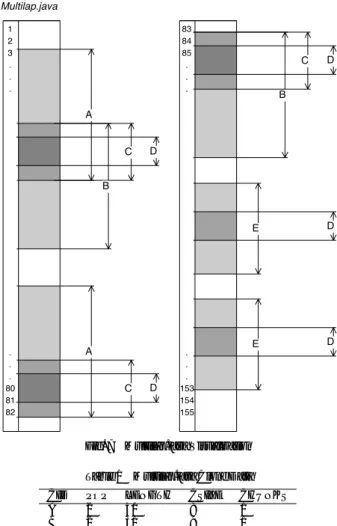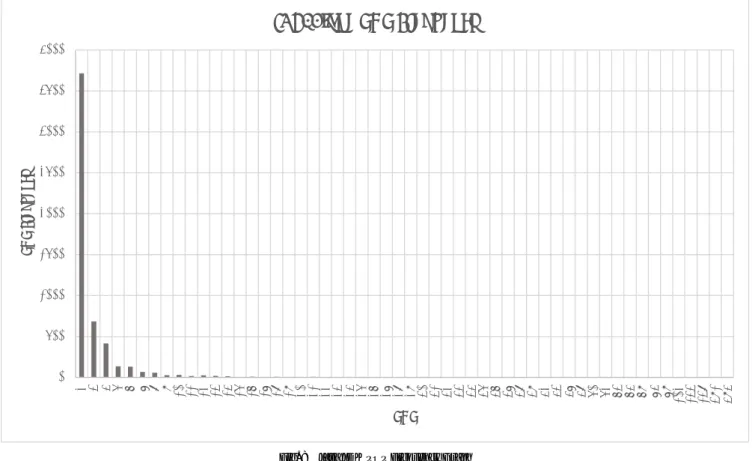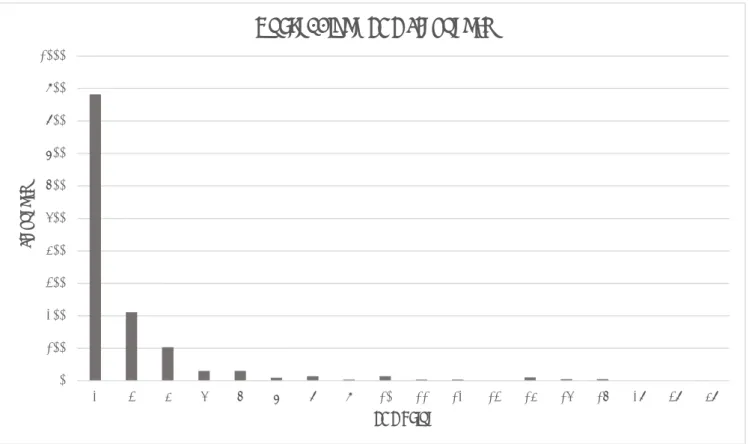Estimating Code Size After a Complete Code-Clone Merge
全文
(2) Vol.2016-SE-192 No.3 Vol.2016-EMB-41 No.3 2016/6/2. IPSJ SIG Technical Report. Fig. 1 Basic idea behind CCM.. overall complexity of the code which may reduce maintenance costs and improve overall readability. One technique to refactor code clones is to extract them from the code and create a shared function that contains the cloned portion, then create calls to that shared function [4]. This is the method by which we are structuring our algorithm.. 3.. Related Works. As previously mentioned there is a lot of research already existing regarding code clones, both how to detect them, and their impact on maintenance. We know code clones are have been shown to increase maintenance costs, and inconsistent changes to cloned sections of code can create faults in the program and lead to incorrect and unintentional program behavior [8]. Indeed, Juergens et al., in their report “Do Code clones Matter?” concludes that “nearly every second unintentionally inconsistent change to a clone leads to a fault” [5]. In addition, some other researches suggest that as a project increases in size it becomes much more likely for unintentional code clones to appear [1]. There are a number of reasons why this may be the case. Reasons may include, but are not limited to, things such as poor communication between programmers on projects that require multiple programmers, as well as development cycles with limited time constraints where copy-and-paste programming may yield quick short-term results but ultimately lead to more expensive maintenance costs. We recognize that if large size projects are especially susceptible to an increased number of code clones, then there is an inherent benefit to creating an algorithm to make this calculation for us, as doing so by hand no. ⓒ 2016 Information Processing Society of Japan. longer becomes a reasonable, time-effective procedure. Due to the nature of code clones, the tools used to detect them, and refactoring, this paper later touches on the problem of overlapping code clones, which has been discussed in detail by other researchers [10]. Many code clone detection tools find portions of code that overlap one another, or detect clones that exist within another clone (embedded clones). This paper does not attempt to solve the issue of overlapping clones in clone detection software, but it does try to work around it.. 4.. Complete Code-Clone Merge. The idea of CCM is relatively simple in theory. We have a source file S of a certain line length |S | and we wish to remove all code clones to create a refactored source file S’ of a certain line length |S ′ | by creating a shared function f for each unique code clone. Each unique code clone will be identified by an ID. The original code clones are then replaced with a call to their respective shared functions fID within the original source code so as to not alter the overall function of the source code. See Figure 1 for an illustration. When creating a shared function let the function have the necessary lines for initialization and termination. We will represent the number of lines necessary for initialization and termination as some constant IT . Additionally, in place of the removed code clone let us add the necessary lines to call the shared function. We will assign constant FC to represent the number of lines necessary for the function call. For there to be a reduction in size, we assume each code clone length is at least of line length IT + FC + 2, thus CloneLength ≥ IT + FC + 2. We know the amount. 2.
(3) Vol.2016-SE-192 No.3 Vol.2016-EMB-41 No.3 2016/6/2. IPSJ SIG Technical Report. code clones, henceforth referred to as T LOC. There are n number of code clones for any given source. For Figure 2, we need to only consider one code clone because n was equal to 1. However, in Figure 1, for example, n = 2. When there exists more than one kind of code clone there may also be a different number of FC required for each clone as this is determined based on the individual clone’s POP. So for each individual clone we need to determine the summation of CloneLength + IT + FC(POP). We will refer to this summation as the add back value, AB.. AB =. n ∑. CloneLengthID + IT + FC × POPID. ID=1. Please note that this method for determining add back is not the completed solution to handle all cases, as we have not yet considered overlapping code clones. We will consider that more advanced case in Section 4.2. However, once we have determined AB, the basic formula for determining the refactored source code size is much more straightforward and will remain the same. It is as follows:. Fig. 2 Source code with 100 lines, only code clone A.. of times the code clone appears in the source code, henceforth referred to as population or POP, is at least 2 (there can be no POP less than this by definition). FC must also be at least one line in length, otherwise there is no replacement call and we would be altering the overall function of the source file. If the assumption concerning code clone length holds we can expect that if S contains any code clones, then after the complete code clone merge |S ′ | < |S |. 4.1 Basic Cases and Examples Perhaps ones of the most basic cases we can consider would be only one code clone pair with no overlapping code clones, as there is only one clone, and a POP of 2. Take Figure 2 as the example. For this case, the equation to find |S ′ | is as follows: |S ′ | = |S | + (−CloneLength × POP + FC × POP +CloneLength + IT ) Using the formula we get the following result, assuming IT = 2 and FC = 1: |S ′ | = 100 + (−15 × 2 + 1 × 2 + 15 + 2) = 100 + (−11) = 89 From this basic example we can see a total of 11 lines are removed from the overall length of the source code. We can discover the |S ′ | value for Figure 1 as well. However, let us consider a simplified equation that will give us the same results if our assumptions hold true about the length of the code clones. Whether by counting manually (as is possible to do here with the small size examples in Figure 1 and Figure 2) or through the use of clone detection software, we can count the total lines of ⓒ 2016 Information Processing Society of Japan. |S ′ | = |S | − T LOC + AB 4.2 Overlapping and Embedded Clones Overlapping code clones are sections of code that are identified as code clones which share a portion of their code with another unique code clone. See Figure 3 for a visualization and example of an overlapping code clone. When overlapping code clones exist, it is no longer possible to simply insert a function call for each code clone. If this were done, the portion of the code that is overlapped would be executed more times than intended. Using Figure 3 as an example, if code clones A and B are refactored out, without accounting for the overlap portion C, and if the the respective function calls for A and B are placed at the lines where code clones A and B begin, the overlap portion C would have its code executed one more time than in the original source. Because our goal is for S ′ to have the same execution result as S this would be unacceptable. 4.2.1 Chunking Method The solution is then to recognize the overlapping portion of code as a code clone and separate it from any surrounding code clones it may be embedded in. In the case of the example in Figure 3, code clone C is embedded in both clones A and B. When C is explicitly separated from clones A and B, the original clones A and B are modified into new code clone “chunks.” In the case of Figure 3, the chunks A’, B’, and C are recognized. We have nicknamed this solution the “Chunking Method.” Now instead of making a function for which to call A and B, a function is created that only calls the lines containing the “chunk portion.” In this case, for A and B, chunks A’ and B’ are the sections of code that do not include code clone C. Additionally, a function is created to call chunk C (which is itself a separate code clone). Chunks A’, B’, and C each have a chunk size of 1. Take note that in some cases, it may be possible to have more than one clone embedded within another clone. In such cases, it 3.
(4) Vol.2016-SE-192 No.3 Vol.2016-EMB-41 No.3 2016/6/2. IPSJ SIG Technical Report. Fig. 3 Overlapping Code Clone Example. Fig. 4. Code Clone Requiring Multiple Chunks. may be necessary to split a code clone into even more chunks if an embedded code clone is located at a point that divides the code clone it is embedded within. See Figure 4 for a visualization and example. This type of case is not uncommon and will be seen again later on. 4.3 Attributes In order to represent code clones overlapping for the purposes of this algorithm we will recognize the attributes of each line in ⓒ 2016 Information Processing Society of Japan. the target source code S . Each line in S either contains a line that is detected as part of a code clone, or it does not. In some cases, as with embedded and overlapping code clones, a line may be part of more than one code clone. The ID, one or more, associated with a code clone will be part of that line’s attributes. If the line has no attributes, we know it is not part of a detected code clone. We will use Figure 5 as an example how we construct the attribute list. This example corresponds to the overlap portion found in Figure 3. For the sake of simplicity, we will say code clone A and B are both 15 lines in length, while code clone C is 5 lines in length. Looking at this attribute list it is easy to see where the overlap exists, and what lines exist to form code clone C. Likewise, it should be clear which parts form chunks A’ and B’. 4.4 CCM Algorithm CCM requires a target source code S and cloned snippet sequence L composed of three tuples, {unique clone ID (ID), starting line (SL), ending line (EL)} as input, and the structure of the refactored source code set S’ where clones in L are merged into new shared functions f and |S’| (size of S’). CCM consists of following five steps:. 4.
(5) Vol.2016-SE-192 No.3 Vol.2016-EMB-41 No.3 2016/6/2. IPSJ SIG Technical Report. Fig. 6 From S to S ′. • If a change of attribute happens, insert a termination statement just before the change, and also insert an initialization statement just after the change (if the line is not deleted). • Delete the lines with attributes with lower ID than f ID. The resulting collection of f ID will be another part of S ′ , and the count of the lines remaining and inserted are another part of |S ′ |. Step 5: Merge and add the results of Step 3 and 4, and formulate S ′ and |S ′ | respectively.. Fig. 5 Attribute list example. Step 0 (preparation): Remove all lines in S that are either empty (whitespace) or contain only comments. For each line in S , prepare an attribute set of clone ID, which is initially empty. Step 1: For each tuple t in L, add an ID to the attribute set of all lines between S L and EL (including those lines). Step 2: For each ID, create one complete cloned snippet as a new shared function f ID. The attribute set of each line is the union of the corresponding line’s attributes for each clone instance with the same ID. Step 3: Scan S from the beginning. • If the change of attribute happens during scanning, we insert a calling statement for a function, except for the lines going back to empty. • Delete lines with non-empty attribute. • Count the number of lines deleted, and also added for the function calls. The resulting source code is a part of S ′ , and the count is also a part of |S ′ |. Step 4: In the same manner, scan each f ID, • Delete the lines having a lower ID than f ID. ⓒ 2016 Information Processing Society of Japan. The time complexity for above Step 0 through 5 are O(1), O(|L| × MaxOverlapLevel(L)), O(|S | × MaxOverlapLevel(L) × MaxOverlapLevel(L)), O(|S | × MaxOverlapLevel(L)), O(|L| × MaxOverlapLevel(L)) and O(1) where MaxOverlapLevel(L) is the max number of levels of overlapping snippets L. Note that Step 2 can be performed by scanning S and creating each f ID and its attributes at the same time. This process can be merged into Step 1. If we assume MaxOverlapLevel(L) is no more than C (a constant value), the total time complexity becomes O(|S |) + O(|L|). The space complexity of CCM is O(|S | × MaxOverlapLevel(L)) + O(|L| × MaxOverlapLevel(L)); if same assumption shown above holds here, O(|S |) + O(|L|).. 5.. CCM Prototype. A prototype tool based on the CCM algorithm has been developed. Using the target source code S and clone data gathered through the use of clone detection software CCFinderX as input the tool will generate data concerning total refactor size as well as an S’ file with comments substituting for function calls (Figure 6).. 6.. Prototype Application. Three examples of source codes and results the CCM Tool has been run are detailed below. They are written in Java or C. However, CCM is not limited to Java source codes. The prototype tool itself is limited to only those languages which CCFinderX can detect clones for. 6.1 Multilap.java The first is a Java source code of relatively few lines written 5.
(6) Vol.2016-SE-192 No.3 Vol.2016-EMB-41 No.3 2016/6/2. IPSJ SIG Technical Report. T otalCS IZE = 8 + 9 + 15 + 7 + 12 = 51 Next we count the number of chunks that are required per code clone. Clones A, B, and D each have a chunk value of 1. However, because they must be split due to another embedded code clone, clones C and E both have a chunk value of 2. We then multiply this number by 2, as this tool assumes the initialization and termination statements for each of the shared functions are both one line each. T otalIT = T otalChunks × IT = (1 + 1 + 2 + 1 + 2) × 2 = 14. Fig. 7. Multilap.java Visualization. Finally we determine the number of function calls that are required by the source code. Beginning from the top of the source code, whenever a new code clone appears we insert a function call statement which we will assume to be 1 line in length. For example, the first clone that appears is A, so we insert a calling statement in place of that code clone. As we continue we next come across C, we insert; we find D, insert; come across C, insert, then B and so on until the end of the source code. Each time we increment the function call counter FC. FC = 19. Table 1 Multilap.java Clone Data CID A B C D E. POP 2 2 3 5 2. LENGTH 30 31 22 7 19. Table 2. CSIZE 8 9 15 7 12. CHUNKS 1 1 2 1 2. We then add all of these values together to determine the AB value and complete the final calculation. AB is now taking into account all cases, including overlapping and embedded clones. AB = T otalCS IZE + T otalIT + FC = 51 + 14 + 19. Multilap Results. Initial Size: Total Clone Length: Reduced Size: LOCs Reduced: Percent Reduction:. 154 138 100 54 35.064934. = 84 ′. |S | = |S | − T LOC + AB = 154 − 138 + 84 = 100. purposely to contain code clones and to demonstrate how CCM handles both overlapping code clones and multi-layered overlaps. Multi-layered overlaps are when code clones are embedded within two or more other detected clones. In the example presented by Figure 7, we have a total of five different code clones and each code clone is assigned a unique clone ID. Although CCFinderX assigns different numbers for each clone ID, we will replace these with letters A through E just for the sake of explanation, the tool itself keeps the ID CCFinderX assigns. In this example, clone A and B overlap, and the overlap portion we will refer to as clone C. Within code clone C, there is clone D, which splits code clone C into two chunks. Clone D can also be found splitting code clone E into two chunks as well. It is from the data in this graph that is used for the final calculations. We first determine the total number of lines that must be included from the code clone sections themselves which comes from a summation of the CSIZE (chunk size) column of the data table (Table 1). ⓒ 2016 Information Processing Society of Japan. Once we have done this calculation we now know the Initial Size (|S |) of the source file, the Total Clone Length, and Reduced Size (|S ′ |) of the source code. Using this information we can determine the Lines of Code (LOC) Reduced by calculating |S | − |S ′ |. We then use LOC Reduced to determine the Percent Reduction. PercentReduction = (LOCReduced/|S |) ∗ 100 = (54/154) ∗ 100 = (.35064934) ∗ 100 = 35.064934 Table 2 summarizes the results. 6.2 Java JDK The prototype tool was also run on the entirety of the Java JDK 1.8.0 77-b03 and results were gathered [12][13]. See Table 3 for the results. Note that the total code length in terms of line numbers is not including lines of whitespace. 6.
(7) Vol.2016-SE-192 No.3 Vol.2016-EMB-41 No.3 2016/6/2. IPSJ SIG Technical Report. JDK: Clone POP Frequency 4000. 3500. POP Frequency. 3000 2500. 2000 1500 1000. 500. 2 3 4 5 6 7 8 9 10 11 12 13 14 15 16 17 18 19 20 21 22 23 24 25 26 27 28 29 30 31 32 33 34 35 36 37 38 39 42 43 47 48 50 52 63 64 69 74 79 102 133 138 391 494. 0. POP Fig. 8. Java JDK POP Frequency Graph. Table 3 Java JDK Results Initial Size: 813546 Total Clone Length: 207072 Reduced Size: 708139. Initial Size: Total Clone Length: Reduced Size:. 216722 49098 194324. LOCs Reduced: Percent Reduction:. LOCs Reduced: Percent Reduction:. 22398 10.3349. Table 4. 105407 12.95649. As can be seen in Table 3 the total percentage of code that can be theoretically refactored using the method we have described in this paper is approximately 13%. This result seems reasonable if we consider the graph displaying the POP frequencies (Figure 8). From the graph we can easily recognize that, at least in the case of the Java JDK, code clones with a POP of 2 are the most common without several thousand more code clones appearing to have a POP of 2 compared even to those with a POP of 3. Considering that code clone volume for this example is approximately 25% (T otalCloneLength/InitialS ize × 100), if we assumed every code clone had a POP of 2 then we would expect to reduce the total volume by about half using the algorithm we have described in this paper. This is because we are essentially reducing the POP of each code clone to 1 by introducing a shared function and substituting function calls where these code clones may appear. 6.3 Quake engine Another example of a large scale source code yielding similar results to that of the Java JDK is the Quake engine. The Quake engine is a game engine written in the C programming language by id Software to run their video game Quake. It was chosen for testing because the source code is available to the public and the code itself consists of several hundred-thousands of lines of code [14]. The results of the test can be observed in Table 4. ⓒ 2016 Information Processing Society of Japan. Quake engine Results. From these results we can observe that the total code clone volume is approximately 22.7%. Because the results tell us the percent that can be refactored by removing code clones is approximately 10.3%, we can expect for clones with a POP of 2 to again be the overwhelming majority of clones that are detected (Figure 9). And again that is precisely what we observe when we graph the frequency of POP values from this source.. 7.. Conclusions. Through the application of this algorithm we are able to determine what percentage could theoretically be refactored if we could merge all instances of code clones, effectively removing all clones from a given source code. The results discussed in the application section seem reasonable as we took a look at the frequency of different POP values. It may be of further interest to research POP frequency from many different large sources. If a trend appears where the most common POP of a code clone is consistently 2, then it may be possible to make the assumption that the total code clone volume that can be refactored by merging code clones would be approximately half that of the total code clone volume as was the case with the Java JDK and to a somewhat lesser extent the Quake engine. 7.
(8) Vol.2016-SE-192 No.3 Vol.2016-EMB-41 No.3 2016/6/2. IPSJ SIG Technical Report. Quake: Clone POP Frequency 1000 900 800. Frequency. 700 600 500 400 300 200 100 0. 2. 3. 4. 5. 6. 7. 8. 9. 10. 11. 12. 13. 14. 15. 16. 28. 38. 48. POP Value Fig. 9. Quake engine POP Frequency Graph. References [1]. [2] [3] [4]. [5]. [6] [7]. [8] [9]. [10]. [11] [12] [13]. Michel Dagenais, Ettore Merlo, Bruno Lagu¨e, and Daniel Proulx. Clones occurrence in large object oriented software packages. In Proceedings of the 8th IBM Centre for Advanced Studies Conference (CASCON ’98), pp. 192-200 (1998). Martin Fowler, Refactoring: Improving the Design of Existing Code, Addison-Wesley (1999). Nils G¨ode, Clone Evolution, Dissertation of University of Bremen, May, 2011. Yoshiki Higo, Toshihiro Kamiya, Shinji Kusumoto, Katsuro Inoue, Refactoring Support Based on Code Clone Analysis, In Proceedings of 5th International Conference on Product Focused Software Process Improvement, pp.220-233 (2004). Elmar Juergens, Florian Deissenboeck, Benjamin Hummel, Stefan Wagner, Do code clones matter?, In Proceedings of the 31st International Conference on Software Engineering (ICSE ’09), pp.485-495 (2009). Cory J. Kapser, Michael W. Godfrey, “Cloning considered harmful” considered harmful: patterns of cloning in software, Empirical Software Engineering, Volume 13 Issue 6, pp.645-692 (2008). Chanchal K. Roy, James R. Cordy, Rainer Koschke, Comparison and evaluation of code clone detection techniques and tools: A qualitative approach, Science of Computer Programming, Volume 74, Issue 7, pp.470-495 (2009). Chanchal K. Roy, James R. Cordy, Rainer Koschke, Comparison and evaluation of code clone detection techniques and tools: A qualitative approach, Sci. Comput. Program., Vol.74, No.7, pp.470-497 (2007). Stefan Wagner, Asim Abdulkhaleq Kamer Kaya, Alexander Paar, On the Relationship of Inconsistent Software Clones and Faults: An Empirical Study, In Proceedings of 23rd International Conference on Software Analysis, Evolution, and Reengineering (SANER2016), pp.79-89 (2016). Pam Green, Peter C.R. Lane, Austen Rainer, Scen-Bodo Scholz, Unscrambling Code Clones for One-to-One Matching of Duplicated Code, In Technical Report No. 502, School of Computer Science, University of Hertfordshire, April, 2010. CCFinderX Official site, http://www.ccfinder.net/ . Java SE | Oracle Technology Network | Oracle, http://www.oracle.com/technetwork/java/javase . ™ Java SE Development Kit 8, Update 77 Release Notes, http://www.oracle.com/technetwork/java/javase/8u77-relnotes2944725.html .. ⓒ 2016 Information Processing Society of Japan. [14]. GitHub - id-Software/Quake: Quake GPL Source Release, https://github.com/id-Software/Quake .. 8.
(9)
図
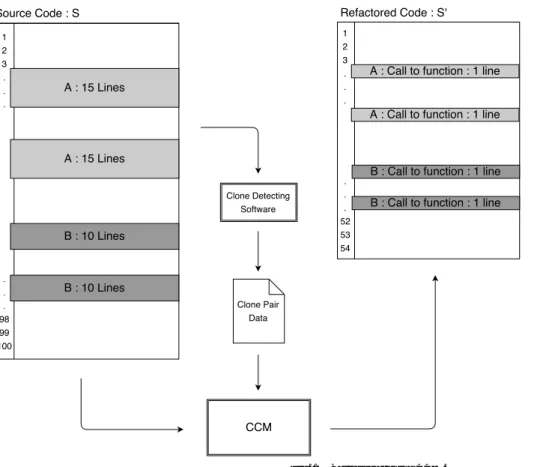

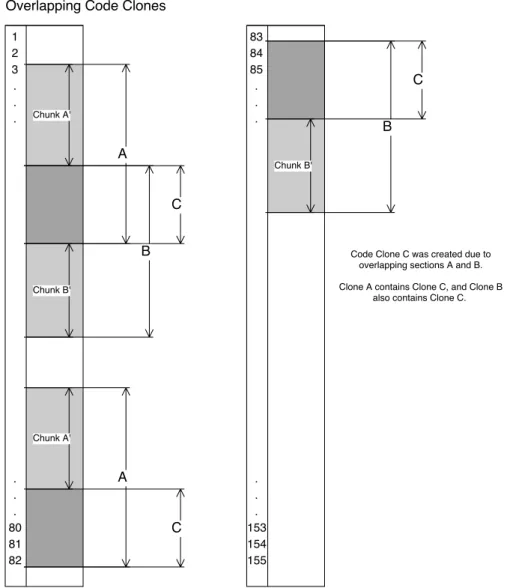
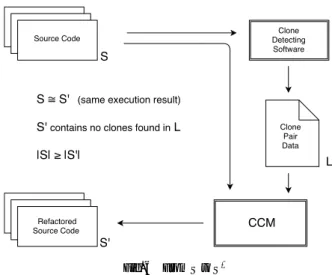
関連したドキュメント
Theorem 1. Tarnanen uses the conjugacy scheme of the group S n in order to obtain new upper bounds for the size of a permutation code. A distance that is both left- and right-
So far, most spectral and analytic properties mirror of M Z 0 those of periodic Schr¨odinger operators, but there are two important differences: (i) M 0 is not bounded from below
In this section we state our main theorems concerning the existence of a unique local solution to (SDP) and the continuous dependence on the initial data... τ is the initial time of
「Was the code entered and accepted by the online
Appendix 3 Data Elements to Be Filed (2) Ocean(Master) Bill of Lading on Cargo InfomationHouse Bill of Lading on Cargo Infomation 11Vessel Code (Call Sign)Vessel Code (Call
Grand Total 1 FOODSTUFF FISH AND FISH PREPARATION MEAT AND MEAT PREPARATION CEREALS, CEREAL PREPARATION VEGETABLES FRUITS 2 RAW MATERIALS WOOD ORE OF NONFERROUS IRON ORE
Amount of Remuneration, etc. The Company does not pay to Directors who concurrently serve as Executive Officer the remuneration paid to Directors. Therefore, “Number of Persons”
If you disclose confidential Company information through social media or networking sites, delete your posting immediately and report the disclosure to your manager or supervisor,
